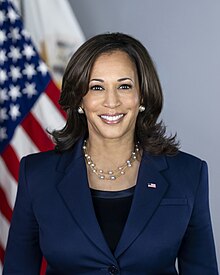
Back Vicepresident d'os Estaus Unius AN نائب رئيس الولايات المتحدة Arabic نايب رئيس امريكا ARZ Vicepresidente d'Estaos Xuníos AST ABŞ vitse-prezidenti Azerbaijani Wakil Présidén Amérika Serikat BAN Bise Presidente kan Estados Unidos BCL Віцэ-прэзідэнт ЗША Byelorussian Вицепрезидент на Съединените американски щати Bulgarian মার্কিন যুক্তরাষ্ট্রের উপরাষ্ট্রপতি Bengali/Bangla
| Vice President of the United States | |
|---|---|
 Seal of the Vice President | |
 Flag of the Vice President | |
| Style |
|
| Member of | |
| Residence | Number One Observatory Circle |
| Seat | Washington, D.C. |
| Appointer | President of the United States Electoral College |
| Term length | Four years, no term limit |
| Constituting instrument | Constitution of the United States |
| Formation | March 4, 1789[1][2][3] |
| First holder | John Adams[4] |
| Succession | First[5] |
| Unofficial names | VPOTUS,[6] VP, Veep[7] |
| Salary | $284,600 (annually) |
| Website | whitehouse.gov |
The vice president of the United States (VPOTUS)[8][9] is the second highest executive officer of the U.S. federal government after the president of the United States. The vice president ranks first in the presidential line of succession and is also the officer of the legislative branch, president of the Senate and the presiding officer of the Senate.[10][11]
Kamala Harris is the 49th and current vice president of the United States, in office since January 2021.[12]
- ↑ "The conventions of nine states having adopted the Constitution, Congress, in September or October, 1788, passed a resolution in conformity with the opinions expressed by the Convention and appointed the first Wednesday in March of the ensuing year as the day, and the then seat of Congress as the place, 'for commencing proceedings under the Constitution.'
"Both governments could not be understood to exist at the same time. The new government did not commence until the old government expired. It is apparent that the government did not commence on the Constitution's being ratified by the ninth state, for these ratifications were to be reported to Congress, whose continuing existence was recognized by the Convention, and who were requested to continue to exercise their powers for the purpose of bringing the new government into operation. In fact, Congress did continue to act as a government until it dissolved on the first of November by the successive disappearance of its members. It existed potentially until 2 March, the day preceding that on which the members of the new Congress were directed to assemble."Owings v. Speed, 18 U.S. (5 Wheat) 420, 422 (1820)
- ↑ Maier, Pauline (2010). Ratification: The People Debate the Constitution, 1787–1788. New York: Simon & Schuster. p. 433. ISBN 978-0-684-86854-7.
- ↑ "March 4: A forgotten huge day in American history". Philadelphia: National Constitution Center. March 4, 2013. Archived from the original on February 24, 2018. Retrieved July 24, 2018.
- ↑ Smith, Page (1962). John Adams. Vol. Two 1784–1826. Garden City, New York: Doubleday. p. 744.
- ↑ Feerick, John. "Essays on Amendment XXV: Presidential Succession". The Heritage Guide to the Constitution. The Heritage Foundation. Archived from the original on August 22, 2020. Retrieved July 3, 2018.
- ↑ "VPOTUS". Merriam-Webster. Archived from the original on January 25, 2021. Retrieved February 10, 2021.
- ↑ "Veep". Merriam-Webster. Archived from the original on October 14, 2020. Retrieved February 14, 2021.
- ↑ "U.S. Senate: About the Vice President (President of the Senate)". www.senate.gov. Retrieved 2023-11-21.
- ↑ "The Vice-Presidency". WHHA (en-US). Retrieved 2023-11-21.
- ↑ "Order of presidential succession | USAGov". www.usa.gov. Retrieved 2023-11-21.
- ↑ "The Executive Branch". The White House. Retrieved 2023-11-21.
- ↑ "Kamala Harris: The Vice President". The White House. Retrieved 2023-02-21.
